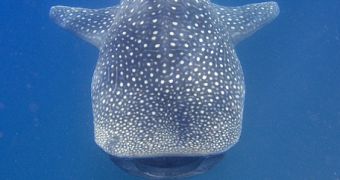A team of researchers discovered that whale sharks – the largest fish in the world, use energy conservation and geometry to stay afloat.
Adrian Gleiss and Rory Wilson, from Swansea University, along with Brad Norman from ECOcean Inc., led an international team to investigate the movements of whale sharks, Rhincodon typus, at Ningaloo Reef in Western Australia, for the past four years.
The swimming activity and vertical movement of the free-swimming whale sharks were measured with animal-borne motion sensors and accelerometers attached to them, and this gave the researchers the opportunity to measure the energetic cost of moving vertically.
All data gathered by the team revealed that whale sharks can glide when descending, without wasting any energy at all, but when they ascended, they are forced to beat their Tails.
This phenomenon only happens because sharks have negative buoyancy, just like many other fish.
The researchers noticed that the steeper the sharks ascended, the harder they had to beat their tail and the more energy they were forced to use.
Actually the whale sharks have two wide movement modes: a shallow ascent angle mode – that minimizes the energy invested in moving horizontally, and a steeper ascent angle mode – that optimizes the energy spending for vertical movement.
Having enough energy at all time for moving, is crucial to all animals, because besides finding food, they need to escape from predators.
The larger the animal, the higher the energy cost, especially for marine animals, which travel in three dimensions.
Lead author Adrian Gleiss from Swansea University, said that “the key factor for animal movement is travel speed, which governs how much energy an animal uses, the distance it will travel and how often resources are encountered.
“However, oceanic animals not only have to consider their travel speed, but also how vertical movement will affect their energy expenditure, which changes the whole perspective.”
Whale sharks are the largest fish species in the ocean, and their movements are based on mathematics and energy conservation, state the marine scientists involved in the study.
They explain that the whale shark uses geometry to increase its natural negative floatability and stay afloat.
Gleiss concluded that the “results demonstrate how geometry plays a crucial role in movement strategies for animals moving in 3-dimensions.
“This use of negative buoyancy may play a large part in oceanic sharks being able to locate and travel between scarce and unpredictable food sources efficiently.”
This research was published today in the British Ecological Society's journal Functional Ecology.

 14 DAY TRIAL //
14 DAY TRIAL //